Effectiveness of Alcohol Management Plans for Indigenous Australians
VerifiedAdded on 2021/06/16
|16
|4879
|416
Report
AI Summary
This report examines the issue of substance abuse, specifically alcohol consumption, within Indigenous Australian communities. It highlights the disproportionately high rates of alcohol use among Aboriginal and Torres Strait Islander populations compared to non-Indigenous Australians and explores the impact of this issue on individual and community health. The report focuses on Alcohol Management Plans (AMPs) implemented in various regions, particularly in Queensland, discussing their features, implementation, and effectiveness. It analyzes the outcomes of these plans, including reductions in alcohol-related violence, hospital admissions, and improvements in community safety, while also acknowledging challenges such as displacement of drinking to other areas and limitations in enforcement. Furthermore, the report provides demographic information about the Indigenous population, including education levels, income, and experiences of social exclusion, emphasizing the factors that contribute to substance abuse. The report also discusses the factors that may detract from the success of AMPs, such as lack of government support and the need for comprehensive community education, and it concludes by underscoring the importance of culturally sensitive, well-enforced, and holistic strategies for addressing alcohol-related harm in Indigenous communities.

Running head: INDIGENOUS SUBSTACNE USE PROGRAM
Aboriginal and/or Torres Strait Islander alcohol use prevention program
Name of the Student
Name of the University
Author Note
Aboriginal and/or Torres Strait Islander alcohol use prevention program
Name of the Student
Name of the University
Author Note
Paraphrase This Document
Need a fresh take? Get an instant paraphrase of this document with our AI Paraphraser
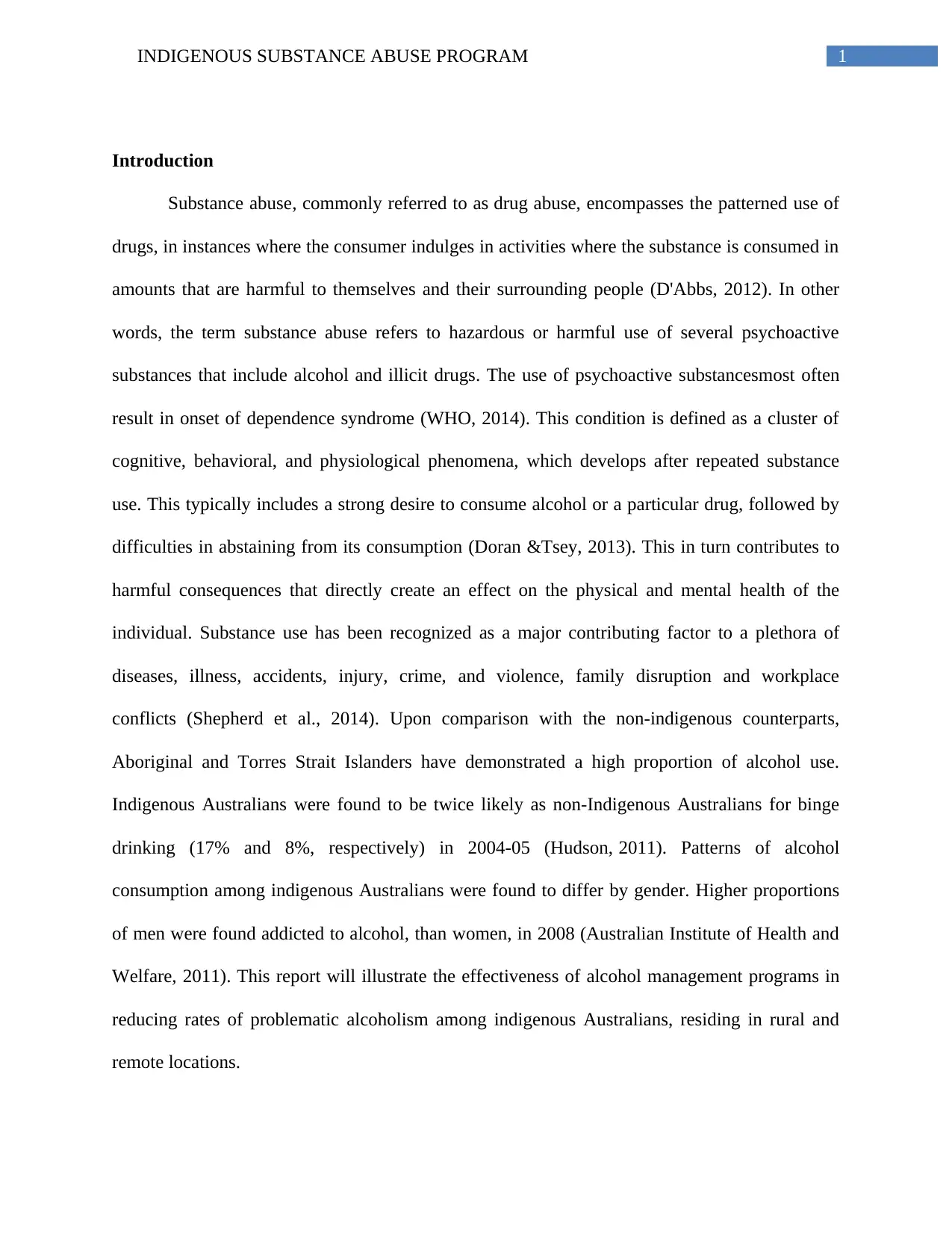
1INDIGENOUS SUBSTANCE ABUSE PROGRAM
Introduction
Substance abuse, commonly referred to as drug abuse, encompasses the patterned use of
drugs, in instances where the consumer indulges in activities where the substance is consumed in
amounts that are harmful to themselves and their surrounding people (D'Abbs, 2012). In other
words, the term substance abuse refers to hazardous or harmful use of several psychoactive
substances that include alcohol and illicit drugs. The use of psychoactive substancesmost often
result in onset of dependence syndrome (WHO, 2014). This condition is defined as a cluster of
cognitive, behavioral, and physiological phenomena, which develops after repeated substance
use. This typically includes a strong desire to consume alcohol or a particular drug, followed by
difficulties in abstaining from its consumption (Doran &Tsey, 2013). This in turn contributes to
harmful consequences that directly create an effect on the physical and mental health of the
individual. Substance use has been recognized as a major contributing factor to a plethora of
diseases, illness, accidents, injury, crime, and violence, family disruption and workplace
conflicts (Shepherd et al., 2014). Upon comparison with the non-indigenous counterparts,
Aboriginal and Torres Strait Islanders have demonstrated a high proportion of alcohol use.
Indigenous Australians were found to be twice likely as non-Indigenous Australians for binge
drinking (17% and 8%, respectively) in 2004-05 (Hudson, 2011). Patterns of alcohol
consumption among indigenous Australians were found to differ by gender. Higher proportions
of men were found addicted to alcohol, than women, in 2008 (Australian Institute of Health and
Welfare, 2011). This report will illustrate the effectiveness of alcohol management programs in
reducing rates of problematic alcoholism among indigenous Australians, residing in rural and
remote locations.
Introduction
Substance abuse, commonly referred to as drug abuse, encompasses the patterned use of
drugs, in instances where the consumer indulges in activities where the substance is consumed in
amounts that are harmful to themselves and their surrounding people (D'Abbs, 2012). In other
words, the term substance abuse refers to hazardous or harmful use of several psychoactive
substances that include alcohol and illicit drugs. The use of psychoactive substancesmost often
result in onset of dependence syndrome (WHO, 2014). This condition is defined as a cluster of
cognitive, behavioral, and physiological phenomena, which develops after repeated substance
use. This typically includes a strong desire to consume alcohol or a particular drug, followed by
difficulties in abstaining from its consumption (Doran &Tsey, 2013). This in turn contributes to
harmful consequences that directly create an effect on the physical and mental health of the
individual. Substance use has been recognized as a major contributing factor to a plethora of
diseases, illness, accidents, injury, crime, and violence, family disruption and workplace
conflicts (Shepherd et al., 2014). Upon comparison with the non-indigenous counterparts,
Aboriginal and Torres Strait Islanders have demonstrated a high proportion of alcohol use.
Indigenous Australians were found to be twice likely as non-Indigenous Australians for binge
drinking (17% and 8%, respectively) in 2004-05 (Hudson, 2011). Patterns of alcohol
consumption among indigenous Australians were found to differ by gender. Higher proportions
of men were found addicted to alcohol, than women, in 2008 (Australian Institute of Health and
Welfare, 2011). This report will illustrate the effectiveness of alcohol management programs in
reducing rates of problematic alcoholism among indigenous Australians, residing in rural and
remote locations.
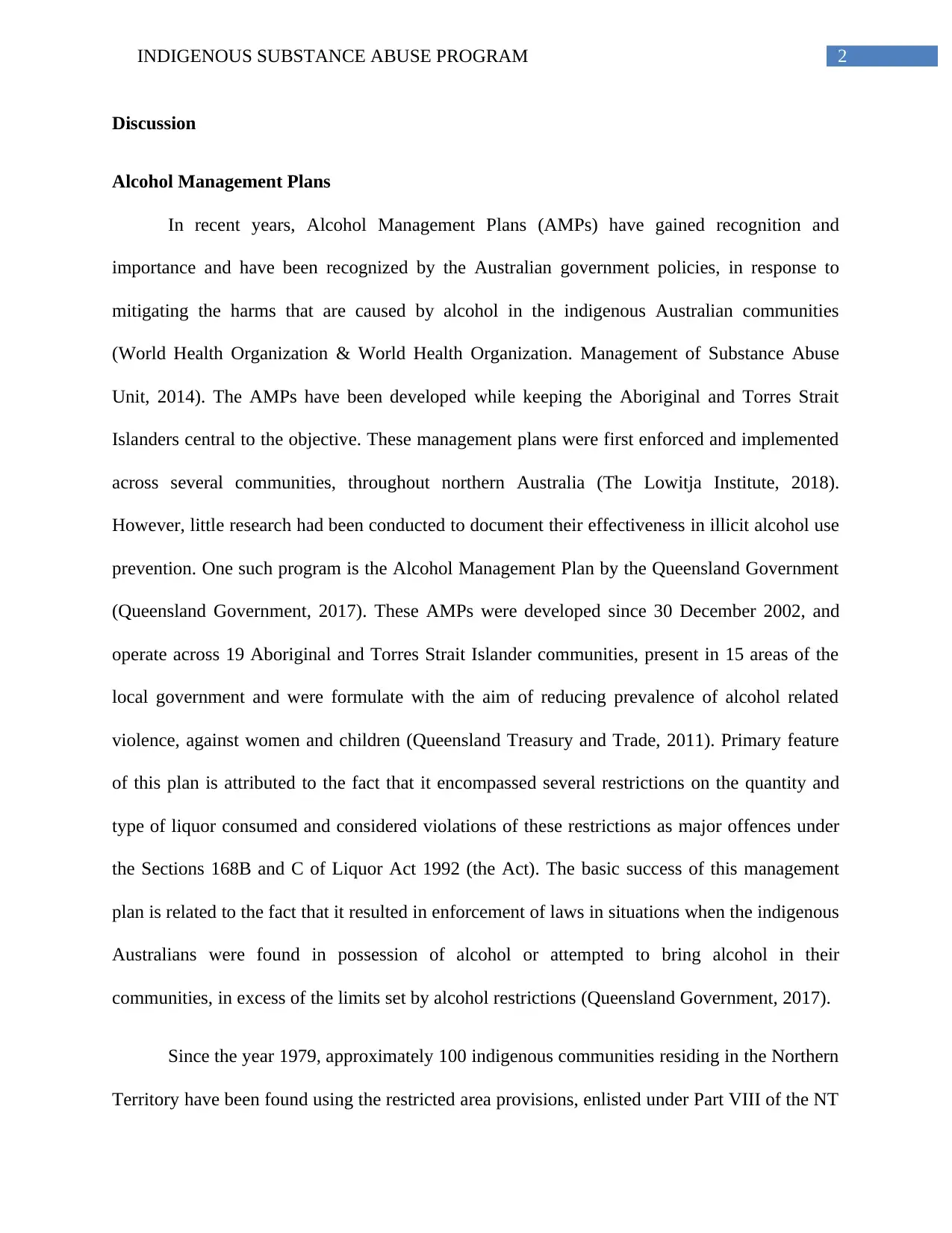
2INDIGENOUS SUBSTANCE ABUSE PROGRAM
Discussion
Alcohol Management Plans
In recent years, Alcohol Management Plans (AMPs) have gained recognition and
importance and have been recognized by the Australian government policies, in response to
mitigating the harms that are caused by alcohol in the indigenous Australian communities
(World Health Organization & World Health Organization. Management of Substance Abuse
Unit, 2014). The AMPs have been developed while keeping the Aboriginal and Torres Strait
Islanders central to the objective. These management plans were first enforced and implemented
across several communities, throughout northern Australia (The Lowitja Institute, 2018).
However, little research had been conducted to document their effectiveness in illicit alcohol use
prevention. One such program is the Alcohol Management Plan by the Queensland Government
(Queensland Government, 2017). These AMPs were developed since 30 December 2002, and
operate across 19 Aboriginal and Torres Strait Islander communities, present in 15 areas of the
local government and were formulate with the aim of reducing prevalence of alcohol related
violence, against women and children (Queensland Treasury and Trade, 2011). Primary feature
of this plan is attributed to the fact that it encompassed several restrictions on the quantity and
type of liquor consumed and considered violations of these restrictions as major offences under
the Sections 168B and C of Liquor Act 1992 (the Act). The basic success of this management
plan is related to the fact that it resulted in enforcement of laws in situations when the indigenous
Australians were found in possession of alcohol or attempted to bring alcohol in their
communities, in excess of the limits set by alcohol restrictions (Queensland Government, 2017).
Since the year 1979, approximately 100 indigenous communities residing in the Northern
Territory have been found using the restricted area provisions, enlisted under Part VIII of the NT
Discussion
Alcohol Management Plans
In recent years, Alcohol Management Plans (AMPs) have gained recognition and
importance and have been recognized by the Australian government policies, in response to
mitigating the harms that are caused by alcohol in the indigenous Australian communities
(World Health Organization & World Health Organization. Management of Substance Abuse
Unit, 2014). The AMPs have been developed while keeping the Aboriginal and Torres Strait
Islanders central to the objective. These management plans were first enforced and implemented
across several communities, throughout northern Australia (The Lowitja Institute, 2018).
However, little research had been conducted to document their effectiveness in illicit alcohol use
prevention. One such program is the Alcohol Management Plan by the Queensland Government
(Queensland Government, 2017). These AMPs were developed since 30 December 2002, and
operate across 19 Aboriginal and Torres Strait Islander communities, present in 15 areas of the
local government and were formulate with the aim of reducing prevalence of alcohol related
violence, against women and children (Queensland Treasury and Trade, 2011). Primary feature
of this plan is attributed to the fact that it encompassed several restrictions on the quantity and
type of liquor consumed and considered violations of these restrictions as major offences under
the Sections 168B and C of Liquor Act 1992 (the Act). The basic success of this management
plan is related to the fact that it resulted in enforcement of laws in situations when the indigenous
Australians were found in possession of alcohol or attempted to bring alcohol in their
communities, in excess of the limits set by alcohol restrictions (Queensland Government, 2017).
Since the year 1979, approximately 100 indigenous communities residing in the Northern
Territory have been found using the restricted area provisions, enlisted under Part VIII of the NT
⊘ This is a preview!⊘
Do you want full access?
Subscribe today to unlock all pages.

Trusted by 1+ million students worldwide
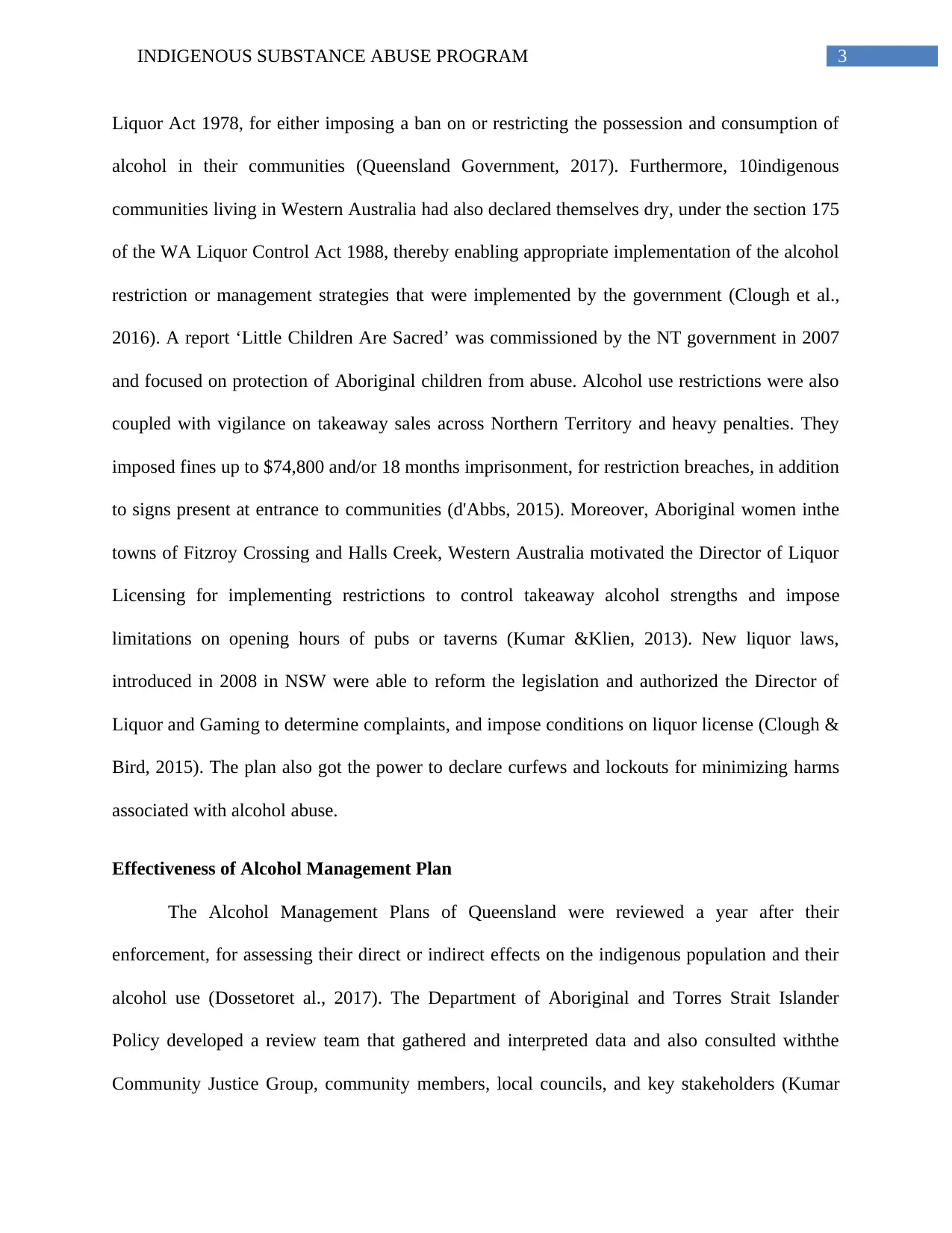
3INDIGENOUS SUBSTANCE ABUSE PROGRAM
Liquor Act 1978, for either imposing a ban on or restricting the possession and consumption of
alcohol in their communities (Queensland Government, 2017). Furthermore, 10indigenous
communities living in Western Australia had also declared themselves dry, under the section 175
of the WA Liquor Control Act 1988, thereby enabling appropriate implementation of the alcohol
restriction or management strategies that were implemented by the government (Clough et al.,
2016). A report ‘Little Children Are Sacred’ was commissioned by the NT government in 2007
and focused on protection of Aboriginal children from abuse. Alcohol use restrictions were also
coupled with vigilance on takeaway sales across Northern Territory and heavy penalties. They
imposed fines up to $74,800 and/or 18 months imprisonment, for restriction breaches, in addition
to signs present at entrance to communities (d'Abbs, 2015). Moreover, Aboriginal women inthe
towns of Fitzroy Crossing and Halls Creek, Western Australia motivated the Director of Liquor
Licensing for implementing restrictions to control takeaway alcohol strengths and impose
limitations on opening hours of pubs or taverns (Kumar &Klien, 2013). New liquor laws,
introduced in 2008 in NSW were able to reform the legislation and authorized the Director of
Liquor and Gaming to determine complaints, and impose conditions on liquor license (Clough &
Bird, 2015). The plan also got the power to declare curfews and lockouts for minimizing harms
associated with alcohol abuse.
Effectiveness of Alcohol Management Plan
The Alcohol Management Plans of Queensland were reviewed a year after their
enforcement, for assessing their direct or indirect effects on the indigenous population and their
alcohol use (Dossetoret al., 2017). The Department of Aboriginal and Torres Strait Islander
Policy developed a review team that gathered and interpreted data and also consulted withthe
Community Justice Group, community members, local councils, and key stakeholders (Kumar
Liquor Act 1978, for either imposing a ban on or restricting the possession and consumption of
alcohol in their communities (Queensland Government, 2017). Furthermore, 10indigenous
communities living in Western Australia had also declared themselves dry, under the section 175
of the WA Liquor Control Act 1988, thereby enabling appropriate implementation of the alcohol
restriction or management strategies that were implemented by the government (Clough et al.,
2016). A report ‘Little Children Are Sacred’ was commissioned by the NT government in 2007
and focused on protection of Aboriginal children from abuse. Alcohol use restrictions were also
coupled with vigilance on takeaway sales across Northern Territory and heavy penalties. They
imposed fines up to $74,800 and/or 18 months imprisonment, for restriction breaches, in addition
to signs present at entrance to communities (d'Abbs, 2015). Moreover, Aboriginal women inthe
towns of Fitzroy Crossing and Halls Creek, Western Australia motivated the Director of Liquor
Licensing for implementing restrictions to control takeaway alcohol strengths and impose
limitations on opening hours of pubs or taverns (Kumar &Klien, 2013). New liquor laws,
introduced in 2008 in NSW were able to reform the legislation and authorized the Director of
Liquor and Gaming to determine complaints, and impose conditions on liquor license (Clough &
Bird, 2015). The plan also got the power to declare curfews and lockouts for minimizing harms
associated with alcohol abuse.
Effectiveness of Alcohol Management Plan
The Alcohol Management Plans of Queensland were reviewed a year after their
enforcement, for assessing their direct or indirect effects on the indigenous population and their
alcohol use (Dossetoret al., 2017). The Department of Aboriginal and Torres Strait Islander
Policy developed a review team that gathered and interpreted data and also consulted withthe
Community Justice Group, community members, local councils, and key stakeholders (Kumar
Paraphrase This Document
Need a fresh take? Get an instant paraphrase of this document with our AI Paraphraser
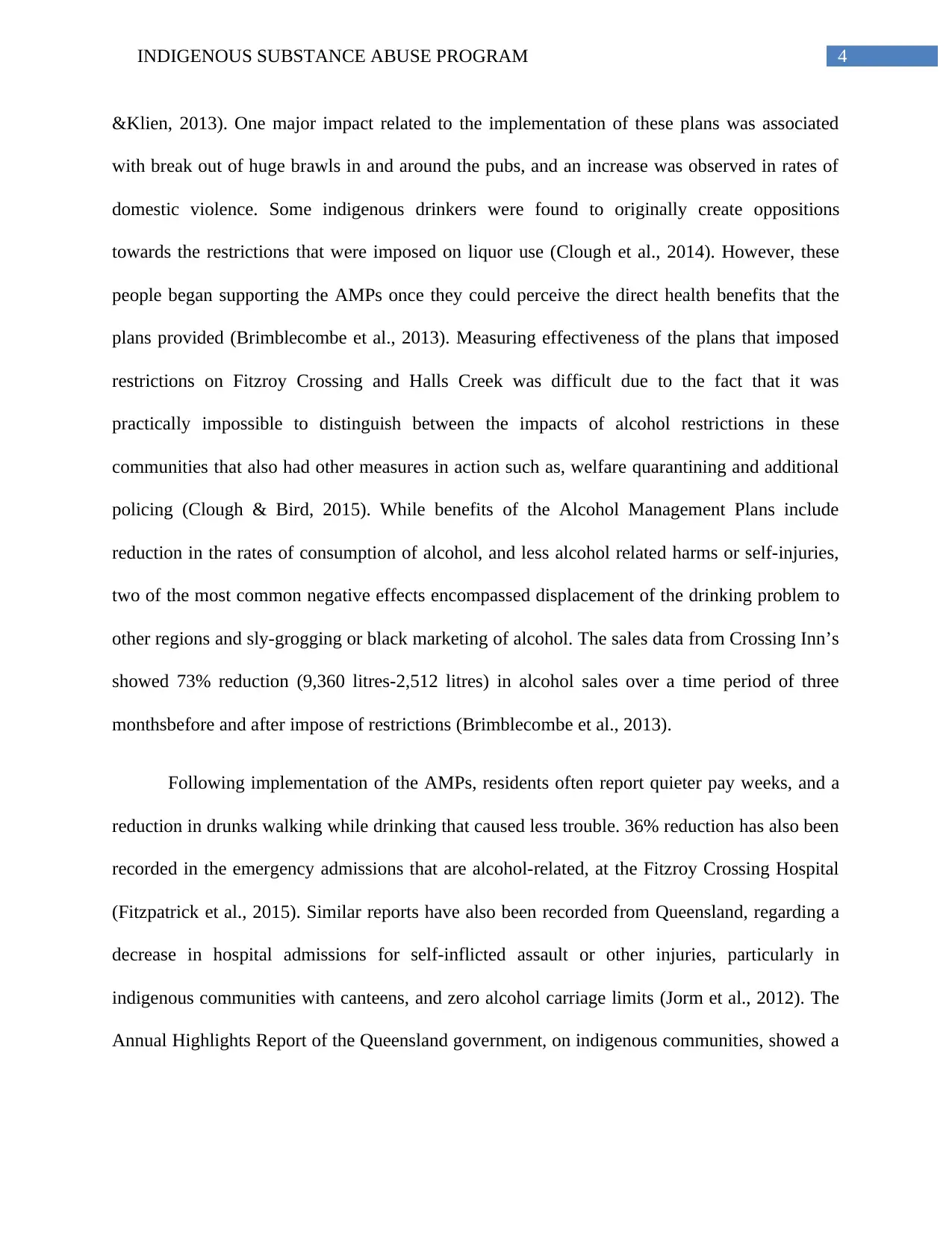
4INDIGENOUS SUBSTANCE ABUSE PROGRAM
&Klien, 2013). One major impact related to the implementation of these plans was associated
with break out of huge brawls in and around the pubs, and an increase was observed in rates of
domestic violence. Some indigenous drinkers were found to originally create oppositions
towards the restrictions that were imposed on liquor use (Clough et al., 2014). However, these
people began supporting the AMPs once they could perceive the direct health benefits that the
plans provided (Brimblecombe et al., 2013). Measuring effectiveness of the plans that imposed
restrictions on Fitzroy Crossing and Halls Creek was difficult due to the fact that it was
practically impossible to distinguish between the impacts of alcohol restrictions in these
communities that also had other measures in action such as, welfare quarantining and additional
policing (Clough & Bird, 2015). While benefits of the Alcohol Management Plans include
reduction in the rates of consumption of alcohol, and less alcohol related harms or self-injuries,
two of the most common negative effects encompassed displacement of the drinking problem to
other regions and sly-grogging or black marketing of alcohol. The sales data from Crossing Inn’s
showed 73% reduction (9,360 litres-2,512 litres) in alcohol sales over a time period of three
monthsbefore and after impose of restrictions (Brimblecombe et al., 2013).
Following implementation of the AMPs, residents often report quieter pay weeks, and a
reduction in drunks walking while drinking that caused less trouble. 36% reduction has also been
recorded in the emergency admissions that are alcohol-related, at the Fitzroy Crossing Hospital
(Fitzpatrick et al., 2015). Similar reports have also been recorded from Queensland, regarding a
decrease in hospital admissions for self-inflicted assault or other injuries, particularly in
indigenous communities with canteens, and zero alcohol carriage limits (Jorm et al., 2012). The
Annual Highlights Report of the Queensland government, on indigenous communities, showed a
&Klien, 2013). One major impact related to the implementation of these plans was associated
with break out of huge brawls in and around the pubs, and an increase was observed in rates of
domestic violence. Some indigenous drinkers were found to originally create oppositions
towards the restrictions that were imposed on liquor use (Clough et al., 2014). However, these
people began supporting the AMPs once they could perceive the direct health benefits that the
plans provided (Brimblecombe et al., 2013). Measuring effectiveness of the plans that imposed
restrictions on Fitzroy Crossing and Halls Creek was difficult due to the fact that it was
practically impossible to distinguish between the impacts of alcohol restrictions in these
communities that also had other measures in action such as, welfare quarantining and additional
policing (Clough & Bird, 2015). While benefits of the Alcohol Management Plans include
reduction in the rates of consumption of alcohol, and less alcohol related harms or self-injuries,
two of the most common negative effects encompassed displacement of the drinking problem to
other regions and sly-grogging or black marketing of alcohol. The sales data from Crossing Inn’s
showed 73% reduction (9,360 litres-2,512 litres) in alcohol sales over a time period of three
monthsbefore and after impose of restrictions (Brimblecombe et al., 2013).
Following implementation of the AMPs, residents often report quieter pay weeks, and a
reduction in drunks walking while drinking that caused less trouble. 36% reduction has also been
recorded in the emergency admissions that are alcohol-related, at the Fitzroy Crossing Hospital
(Fitzpatrick et al., 2015). Similar reports have also been recorded from Queensland, regarding a
decrease in hospital admissions for self-inflicted assault or other injuries, particularly in
indigenous communities with canteens, and zero alcohol carriage limits (Jorm et al., 2012). The
Annual Highlights Report of the Queensland government, on indigenous communities, showed a
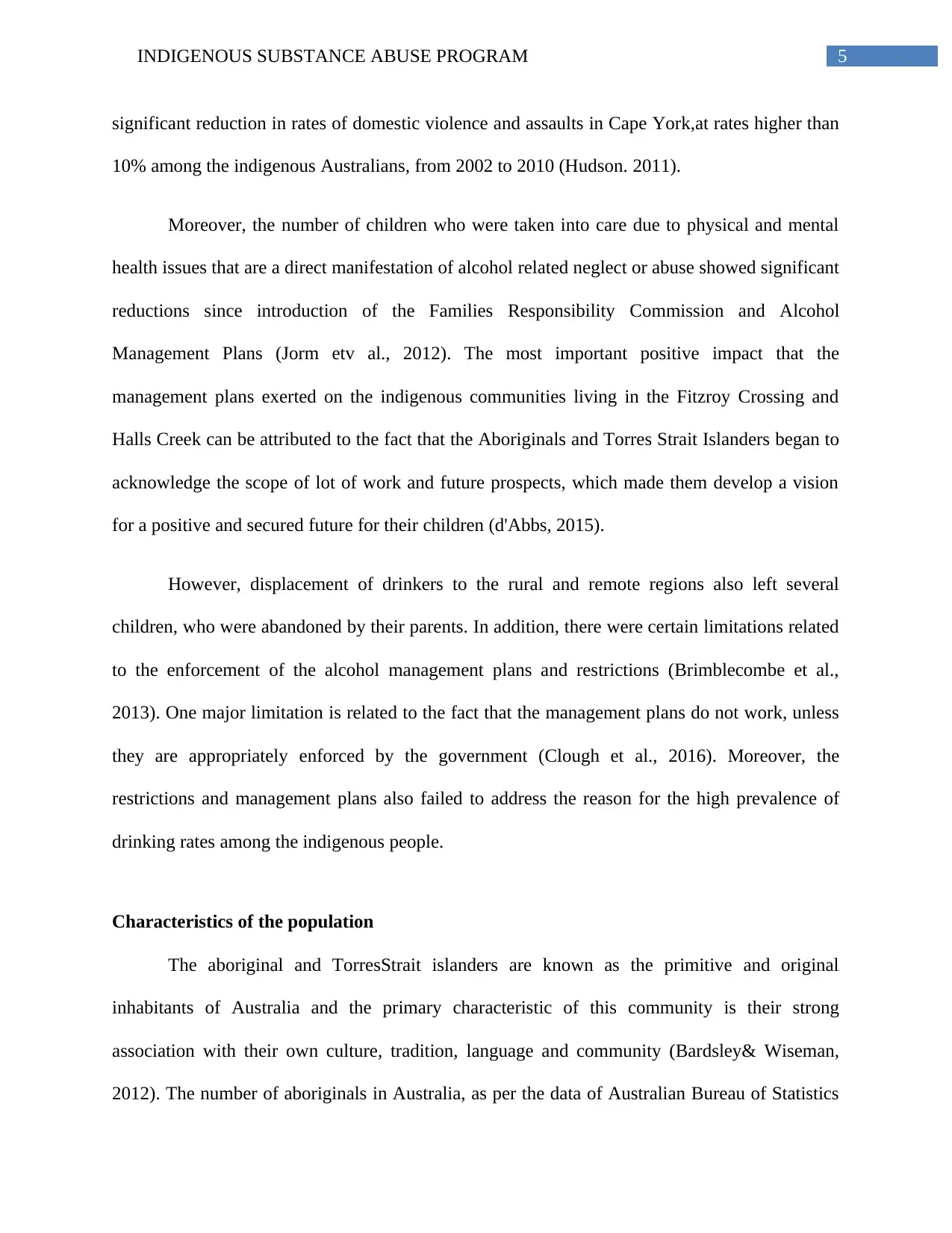
5INDIGENOUS SUBSTANCE ABUSE PROGRAM
significant reduction in rates of domestic violence and assaults in Cape York,at rates higher than
10% among the indigenous Australians, from 2002 to 2010 (Hudson. 2011).
Moreover, the number of children who were taken into care due to physical and mental
health issues that are a direct manifestation of alcohol related neglect or abuse showed significant
reductions since introduction of the Families Responsibility Commission and Alcohol
Management Plans (Jorm etv al., 2012). The most important positive impact that the
management plans exerted on the indigenous communities living in the Fitzroy Crossing and
Halls Creek can be attributed to the fact that the Aboriginals and Torres Strait Islanders began to
acknowledge the scope of lot of work and future prospects, which made them develop a vision
for a positive and secured future for their children (d'Abbs, 2015).
However, displacement of drinkers to the rural and remote regions also left several
children, who were abandoned by their parents. In addition, there were certain limitations related
to the enforcement of the alcohol management plans and restrictions (Brimblecombe et al.,
2013). One major limitation is related to the fact that the management plans do not work, unless
they are appropriately enforced by the government (Clough et al., 2016). Moreover, the
restrictions and management plans also failed to address the reason for the high prevalence of
drinking rates among the indigenous people.
Characteristics of the population
The aboriginal and TorresStrait islanders are known as the primitive and original
inhabitants of Australia and the primary characteristic of this community is their strong
association with their own culture, tradition, language and community (Bardsley& Wiseman,
2012). The number of aboriginals in Australia, as per the data of Australian Bureau of Statistics
significant reduction in rates of domestic violence and assaults in Cape York,at rates higher than
10% among the indigenous Australians, from 2002 to 2010 (Hudson. 2011).
Moreover, the number of children who were taken into care due to physical and mental
health issues that are a direct manifestation of alcohol related neglect or abuse showed significant
reductions since introduction of the Families Responsibility Commission and Alcohol
Management Plans (Jorm etv al., 2012). The most important positive impact that the
management plans exerted on the indigenous communities living in the Fitzroy Crossing and
Halls Creek can be attributed to the fact that the Aboriginals and Torres Strait Islanders began to
acknowledge the scope of lot of work and future prospects, which made them develop a vision
for a positive and secured future for their children (d'Abbs, 2015).
However, displacement of drinkers to the rural and remote regions also left several
children, who were abandoned by their parents. In addition, there were certain limitations related
to the enforcement of the alcohol management plans and restrictions (Brimblecombe et al.,
2013). One major limitation is related to the fact that the management plans do not work, unless
they are appropriately enforced by the government (Clough et al., 2016). Moreover, the
restrictions and management plans also failed to address the reason for the high prevalence of
drinking rates among the indigenous people.
Characteristics of the population
The aboriginal and TorresStrait islanders are known as the primitive and original
inhabitants of Australia and the primary characteristic of this community is their strong
association with their own culture, tradition, language and community (Bardsley& Wiseman,
2012). The number of aboriginals in Australia, as per the data of Australian Bureau of Statistics
⊘ This is a preview!⊘
Do you want full access?
Subscribe today to unlock all pages.

Trusted by 1+ million students worldwide
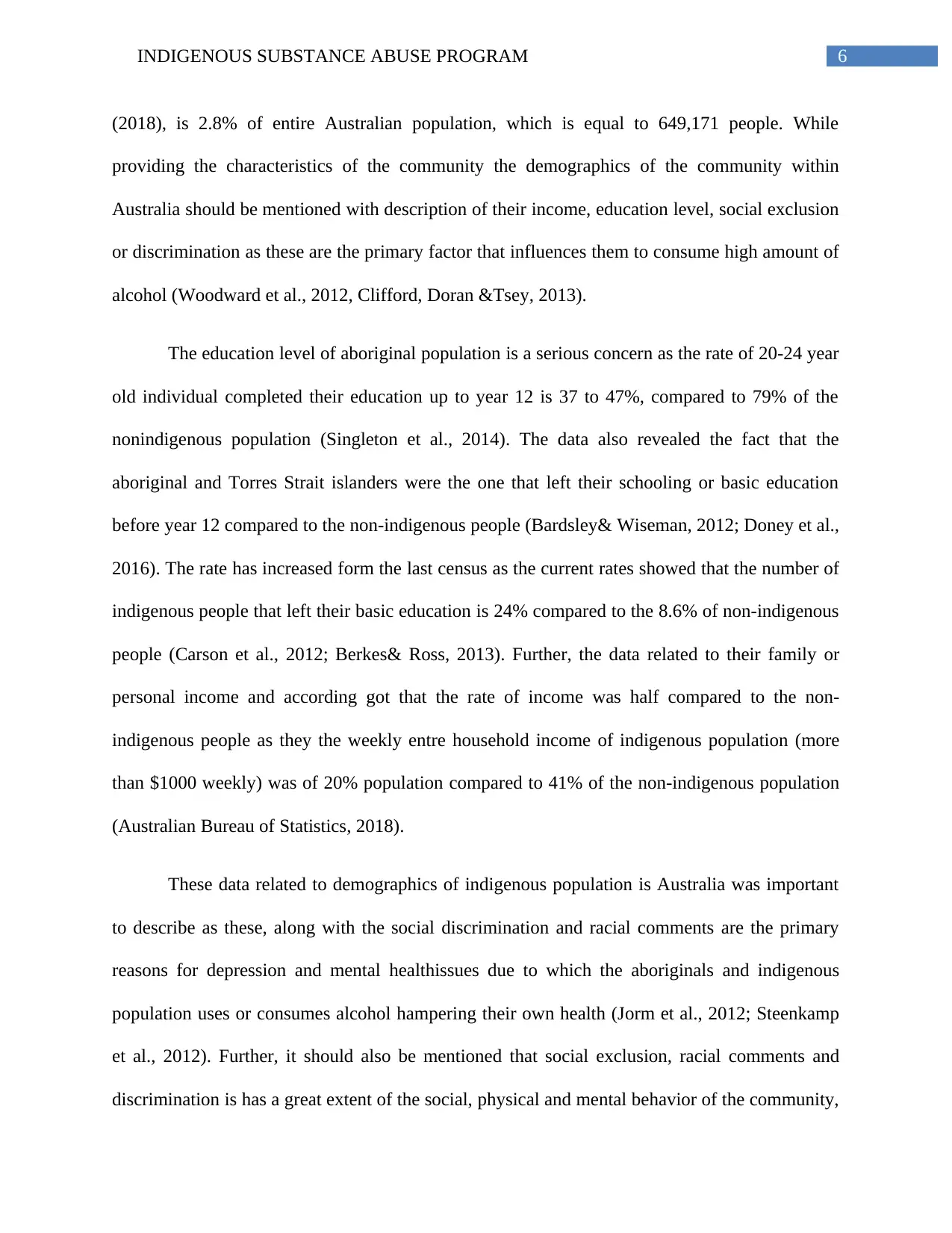
6INDIGENOUS SUBSTANCE ABUSE PROGRAM
(2018), is 2.8% of entire Australian population, which is equal to 649,171 people. While
providing the characteristics of the community the demographics of the community within
Australia should be mentioned with description of their income, education level, social exclusion
or discrimination as these are the primary factor that influences them to consume high amount of
alcohol (Woodward et al., 2012, Clifford, Doran &Tsey, 2013).
The education level of aboriginal population is a serious concern as the rate of 20-24 year
old individual completed their education up to year 12 is 37 to 47%, compared to 79% of the
nonindigenous population (Singleton et al., 2014). The data also revealed the fact that the
aboriginal and Torres Strait islanders were the one that left their schooling or basic education
before year 12 compared to the non-indigenous people (Bardsley& Wiseman, 2012; Doney et al.,
2016). The rate has increased form the last census as the current rates showed that the number of
indigenous people that left their basic education is 24% compared to the 8.6% of non-indigenous
people (Carson et al., 2012; Berkes& Ross, 2013). Further, the data related to their family or
personal income and according got that the rate of income was half compared to the non-
indigenous people as they the weekly entre household income of indigenous population (more
than $1000 weekly) was of 20% population compared to 41% of the non-indigenous population
(Australian Bureau of Statistics, 2018).
These data related to demographics of indigenous population is Australia was important
to describe as these, along with the social discrimination and racial comments are the primary
reasons for depression and mental healthissues due to which the aboriginals and indigenous
population uses or consumes alcohol hampering their own health (Jorm et al., 2012; Steenkamp
et al., 2012). Further, it should also be mentioned that social exclusion, racial comments and
discrimination is has a great extent of the social, physical and mental behavior of the community,
(2018), is 2.8% of entire Australian population, which is equal to 649,171 people. While
providing the characteristics of the community the demographics of the community within
Australia should be mentioned with description of their income, education level, social exclusion
or discrimination as these are the primary factor that influences them to consume high amount of
alcohol (Woodward et al., 2012, Clifford, Doran &Tsey, 2013).
The education level of aboriginal population is a serious concern as the rate of 20-24 year
old individual completed their education up to year 12 is 37 to 47%, compared to 79% of the
nonindigenous population (Singleton et al., 2014). The data also revealed the fact that the
aboriginal and Torres Strait islanders were the one that left their schooling or basic education
before year 12 compared to the non-indigenous people (Bardsley& Wiseman, 2012; Doney et al.,
2016). The rate has increased form the last census as the current rates showed that the number of
indigenous people that left their basic education is 24% compared to the 8.6% of non-indigenous
people (Carson et al., 2012; Berkes& Ross, 2013). Further, the data related to their family or
personal income and according got that the rate of income was half compared to the non-
indigenous people as they the weekly entre household income of indigenous population (more
than $1000 weekly) was of 20% population compared to 41% of the non-indigenous population
(Australian Bureau of Statistics, 2018).
These data related to demographics of indigenous population is Australia was important
to describe as these, along with the social discrimination and racial comments are the primary
reasons for depression and mental healthissues due to which the aboriginals and indigenous
population uses or consumes alcohol hampering their own health (Jorm et al., 2012; Steenkamp
et al., 2012). Further, it should also be mentioned that social exclusion, racial comments and
discrimination is has a great extent of the social, physical and mental behavior of the community,
Paraphrase This Document
Need a fresh take? Get an instant paraphrase of this document with our AI Paraphraser
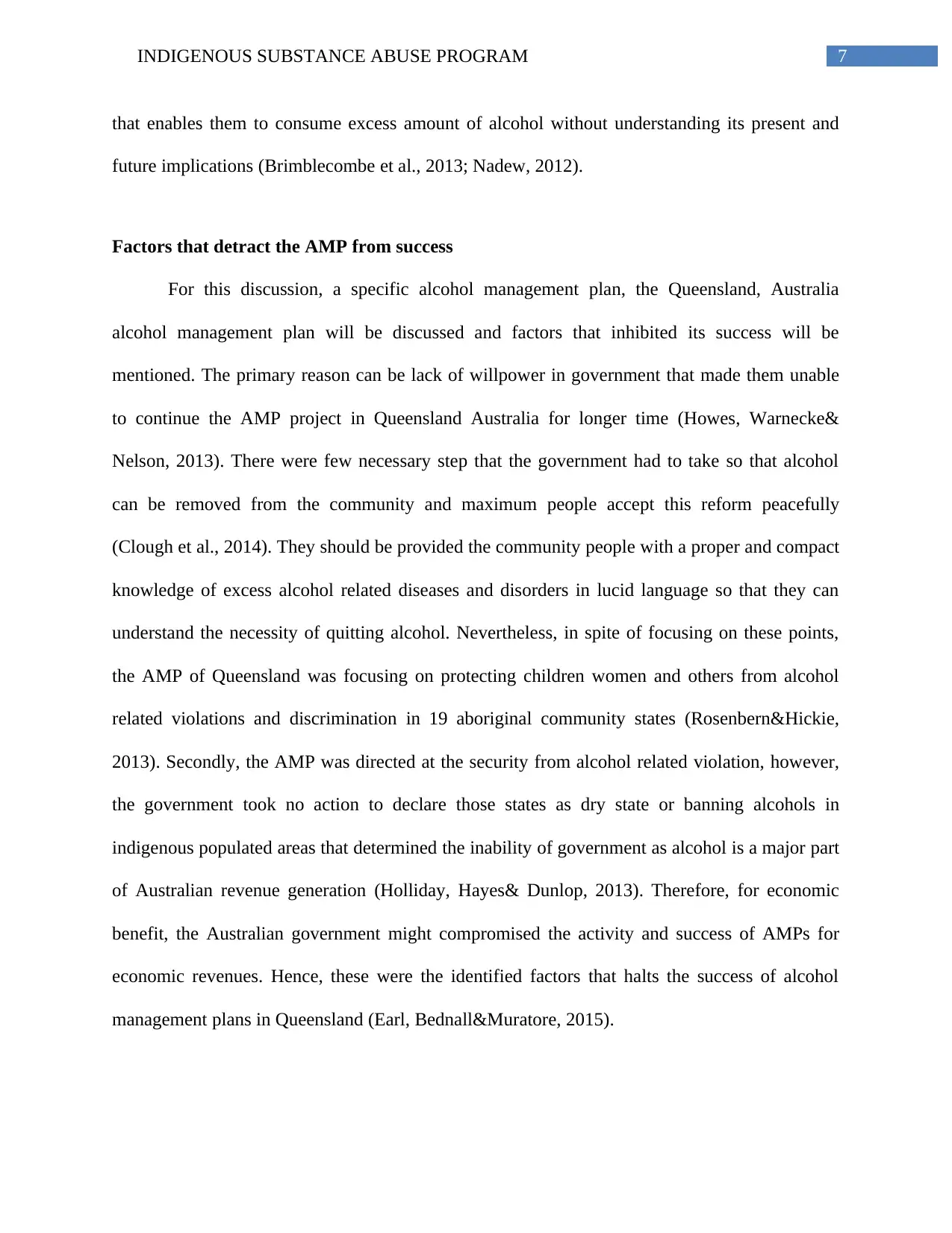
7INDIGENOUS SUBSTANCE ABUSE PROGRAM
that enables them to consume excess amount of alcohol without understanding its present and
future implications (Brimblecombe et al., 2013; Nadew, 2012).
Factors that detract the AMP from success
For this discussion, a specific alcohol management plan, the Queensland, Australia
alcohol management plan will be discussed and factors that inhibited its success will be
mentioned. The primary reason can be lack of willpower in government that made them unable
to continue the AMP project in Queensland Australia for longer time (Howes, Warnecke&
Nelson, 2013). There were few necessary step that the government had to take so that alcohol
can be removed from the community and maximum people accept this reform peacefully
(Clough et al., 2014). They should be provided the community people with a proper and compact
knowledge of excess alcohol related diseases and disorders in lucid language so that they can
understand the necessity of quitting alcohol. Nevertheless, in spite of focusing on these points,
the AMP of Queensland was focusing on protecting children women and others from alcohol
related violations and discrimination in 19 aboriginal community states (Rosenbern&Hickie,
2013). Secondly, the AMP was directed at the security from alcohol related violation, however,
the government took no action to declare those states as dry state or banning alcohols in
indigenous populated areas that determined the inability of government as alcohol is a major part
of Australian revenue generation (Holliday, Hayes& Dunlop, 2013). Therefore, for economic
benefit, the Australian government might compromised the activity and success of AMPs for
economic revenues. Hence, these were the identified factors that halts the success of alcohol
management plans in Queensland (Earl, Bednall&Muratore, 2015).
that enables them to consume excess amount of alcohol without understanding its present and
future implications (Brimblecombe et al., 2013; Nadew, 2012).
Factors that detract the AMP from success
For this discussion, a specific alcohol management plan, the Queensland, Australia
alcohol management plan will be discussed and factors that inhibited its success will be
mentioned. The primary reason can be lack of willpower in government that made them unable
to continue the AMP project in Queensland Australia for longer time (Howes, Warnecke&
Nelson, 2013). There were few necessary step that the government had to take so that alcohol
can be removed from the community and maximum people accept this reform peacefully
(Clough et al., 2014). They should be provided the community people with a proper and compact
knowledge of excess alcohol related diseases and disorders in lucid language so that they can
understand the necessity of quitting alcohol. Nevertheless, in spite of focusing on these points,
the AMP of Queensland was focusing on protecting children women and others from alcohol
related violations and discrimination in 19 aboriginal community states (Rosenbern&Hickie,
2013). Secondly, the AMP was directed at the security from alcohol related violation, however,
the government took no action to declare those states as dry state or banning alcohols in
indigenous populated areas that determined the inability of government as alcohol is a major part
of Australian revenue generation (Holliday, Hayes& Dunlop, 2013). Therefore, for economic
benefit, the Australian government might compromised the activity and success of AMPs for
economic revenues. Hence, these were the identified factors that halts the success of alcohol
management plans in Queensland (Earl, Bednall&Muratore, 2015).

8INDIGENOUS SUBSTANCE ABUSE PROGRAM
Why these programs are appropriate for indigenous community
These alcohol management plans are important for indigenous population of Australia as
due to these, the level of alcohol consumption is decreasing and the data from ABS has shown
that 2.13% alcohol consumption in Australian indigenous population has been noted (McCalman
et al., 2012). Besides these, in different aspects such as their involvement in cultural safety
interventions, integration of their family, increasing education and income related rates has
increased (Watkins et al., 2013). These indicated towards the fact that despite of several
shortcomings and loopholes present in the alcohol management policy, the rate of alcohol
consumption is decreasing slowly and steadily (Browne, Hayes& Gleeson, 2014).
Besides these positive points, there are several negative points, for improvement of
which, the level of alcohol consumption in Australian aboriginals should be decreased and hence
AMPs need to implemented with string and determined will power of the government
(Campbell, McAlister&Quan, 2013; Clifford, Shakeshaft& Deans, 2012). The data from
Australian Bureau of Statistics determined that indigenous aboriginal’s community is suffering
from alcohol driven disorders mostly.
Besides these, there is a major concern which is binge drinking among indigenous
community that is causing deaths, suicides, road accidents and social crimes attempted by the
indigenous population (Bray et al., 2014; D'Abbs, 2012). there are more than 43% families in the
indigenous community that are suffering from substance abuse related violence and crimes,
hence, for this purpose also, it is very important for the government to carry out alcohol
management programs so that these rates can be decreased and the knowledge related to alcohol
use and its bad effects can be reinforced on the indigenous community, to improve their social,
physical, mental and behavioral conditions (Gracey, 2014, Jayaraj et al., 2013).
Why these programs are appropriate for indigenous community
These alcohol management plans are important for indigenous population of Australia as
due to these, the level of alcohol consumption is decreasing and the data from ABS has shown
that 2.13% alcohol consumption in Australian indigenous population has been noted (McCalman
et al., 2012). Besides these, in different aspects such as their involvement in cultural safety
interventions, integration of their family, increasing education and income related rates has
increased (Watkins et al., 2013). These indicated towards the fact that despite of several
shortcomings and loopholes present in the alcohol management policy, the rate of alcohol
consumption is decreasing slowly and steadily (Browne, Hayes& Gleeson, 2014).
Besides these positive points, there are several negative points, for improvement of
which, the level of alcohol consumption in Australian aboriginals should be decreased and hence
AMPs need to implemented with string and determined will power of the government
(Campbell, McAlister&Quan, 2013; Clifford, Shakeshaft& Deans, 2012). The data from
Australian Bureau of Statistics determined that indigenous aboriginal’s community is suffering
from alcohol driven disorders mostly.
Besides these, there is a major concern which is binge drinking among indigenous
community that is causing deaths, suicides, road accidents and social crimes attempted by the
indigenous population (Bray et al., 2014; D'Abbs, 2012). there are more than 43% families in the
indigenous community that are suffering from substance abuse related violence and crimes,
hence, for this purpose also, it is very important for the government to carry out alcohol
management programs so that these rates can be decreased and the knowledge related to alcohol
use and its bad effects can be reinforced on the indigenous community, to improve their social,
physical, mental and behavioral conditions (Gracey, 2014, Jayaraj et al., 2013).
⊘ This is a preview!⊘
Do you want full access?
Subscribe today to unlock all pages.

Trusted by 1+ million students worldwide
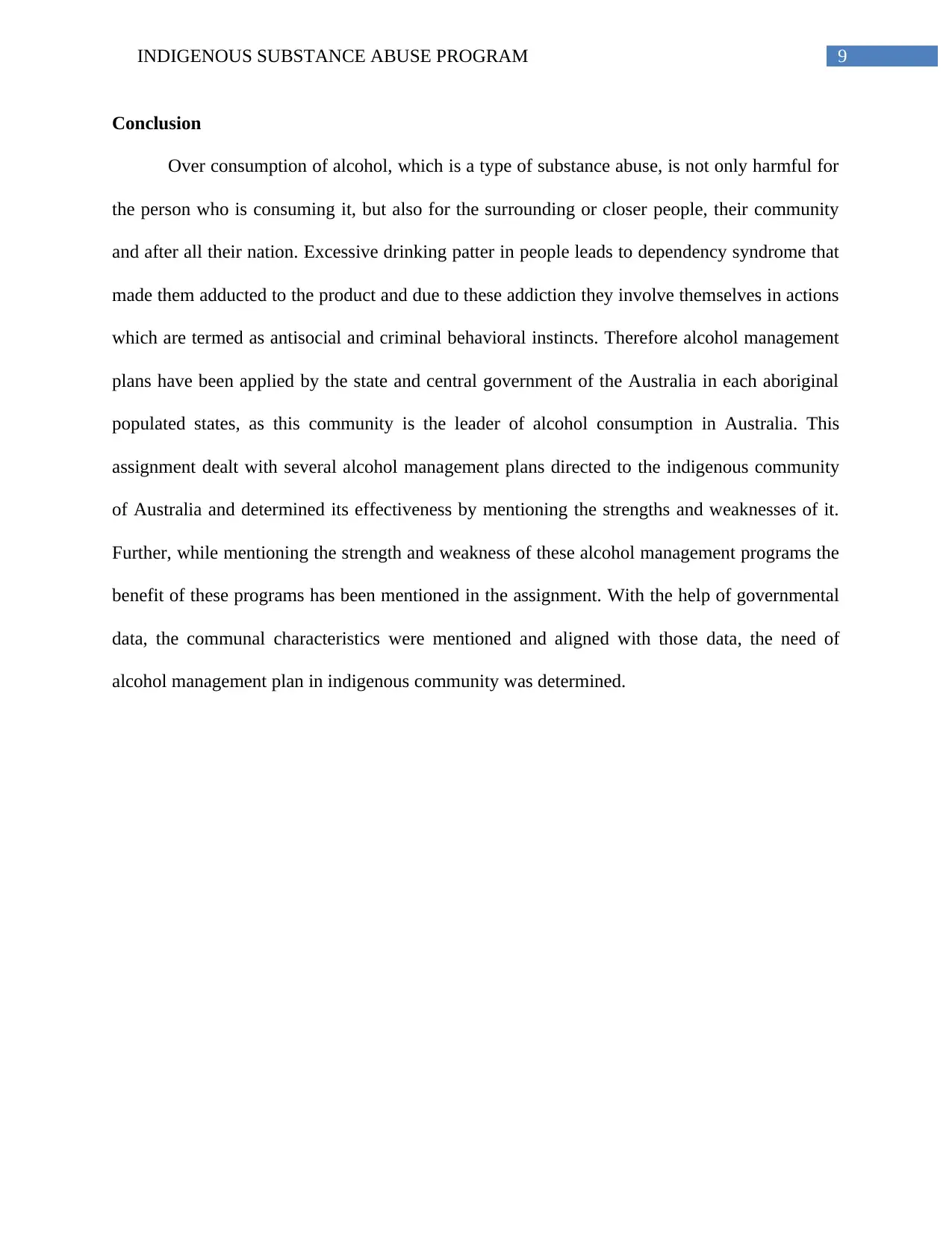
9INDIGENOUS SUBSTANCE ABUSE PROGRAM
Conclusion
Over consumption of alcohol, which is a type of substance abuse, is not only harmful for
the person who is consuming it, but also for the surrounding or closer people, their community
and after all their nation. Excessive drinking patter in people leads to dependency syndrome that
made them adducted to the product and due to these addiction they involve themselves in actions
which are termed as antisocial and criminal behavioral instincts. Therefore alcohol management
plans have been applied by the state and central government of the Australia in each aboriginal
populated states, as this community is the leader of alcohol consumption in Australia. This
assignment dealt with several alcohol management plans directed to the indigenous community
of Australia and determined its effectiveness by mentioning the strengths and weaknesses of it.
Further, while mentioning the strength and weakness of these alcohol management programs the
benefit of these programs has been mentioned in the assignment. With the help of governmental
data, the communal characteristics were mentioned and aligned with those data, the need of
alcohol management plan in indigenous community was determined.
Conclusion
Over consumption of alcohol, which is a type of substance abuse, is not only harmful for
the person who is consuming it, but also for the surrounding or closer people, their community
and after all their nation. Excessive drinking patter in people leads to dependency syndrome that
made them adducted to the product and due to these addiction they involve themselves in actions
which are termed as antisocial and criminal behavioral instincts. Therefore alcohol management
plans have been applied by the state and central government of the Australia in each aboriginal
populated states, as this community is the leader of alcohol consumption in Australia. This
assignment dealt with several alcohol management plans directed to the indigenous community
of Australia and determined its effectiveness by mentioning the strengths and weaknesses of it.
Further, while mentioning the strength and weakness of these alcohol management programs the
benefit of these programs has been mentioned in the assignment. With the help of governmental
data, the communal characteristics were mentioned and aligned with those data, the need of
alcohol management plan in indigenous community was determined.
Paraphrase This Document
Need a fresh take? Get an instant paraphrase of this document with our AI Paraphraser

10INDIGENOUS SUBSTANCE ABUSE PROGRAM
References
Australian Bureau of Statistics (2018). 2071.0 - Census of Population and Housing: Reflecting
Australia - Stories from the Census, 2016. [online] Abs.gov.au. Available at:
http://www.abs.gov.au/ausstats/abs@.nsf/Lookup/by%20Subject/2071.0~2016~Main
%20Features~Aboriginal%20and%20Torres%20Strait%20Islander%20Population
%20Data%20Summary~10 [Accessed 18 May 2018].
Australian Institute of Health and Welfare. (2011). Substance use among Aboriginal and Torres
Strait Islander people. Retrieved from https://www.aihw.gov.au/getmedia/7eb356be-
c2cd-4562-a240-010cbbe257f2/11503.pdf.aspx?inline=true.
Bardsley, D. K., & Wiseman, N. D. (2012). Climate change vulnerability and social development
for remote indigenous communities of South Australia. Global Environmental
Change, 22(3), 713-723.
Berkes, F., & Ross, H. (2013). Community resilience: toward an integrated approach. Society &
Natural Resources, 26(1), 5-20.
Bray, J. R., Gray, M., Hand, K., & Katz, I. (2014). Evaluating new income management in the
Northern Territory: final evaluation report. Social Policy Research Centre, Sydney.
Brimblecombe, J. K., Ferguson, M. M., Liberato, S. C., & O'Dea, K. (2013). Characteristics of
the community-level diet of Aboriginal people in remote northern Australia. Medical
journal of Australia, 198(7), 380-384.
References
Australian Bureau of Statistics (2018). 2071.0 - Census of Population and Housing: Reflecting
Australia - Stories from the Census, 2016. [online] Abs.gov.au. Available at:
http://www.abs.gov.au/ausstats/abs@.nsf/Lookup/by%20Subject/2071.0~2016~Main
%20Features~Aboriginal%20and%20Torres%20Strait%20Islander%20Population
%20Data%20Summary~10 [Accessed 18 May 2018].
Australian Institute of Health and Welfare. (2011). Substance use among Aboriginal and Torres
Strait Islander people. Retrieved from https://www.aihw.gov.au/getmedia/7eb356be-
c2cd-4562-a240-010cbbe257f2/11503.pdf.aspx?inline=true.
Bardsley, D. K., & Wiseman, N. D. (2012). Climate change vulnerability and social development
for remote indigenous communities of South Australia. Global Environmental
Change, 22(3), 713-723.
Berkes, F., & Ross, H. (2013). Community resilience: toward an integrated approach. Society &
Natural Resources, 26(1), 5-20.
Bray, J. R., Gray, M., Hand, K., & Katz, I. (2014). Evaluating new income management in the
Northern Territory: final evaluation report. Social Policy Research Centre, Sydney.
Brimblecombe, J. K., Ferguson, M. M., Liberato, S. C., & O'Dea, K. (2013). Characteristics of
the community-level diet of Aboriginal people in remote northern Australia. Medical
journal of Australia, 198(7), 380-384.
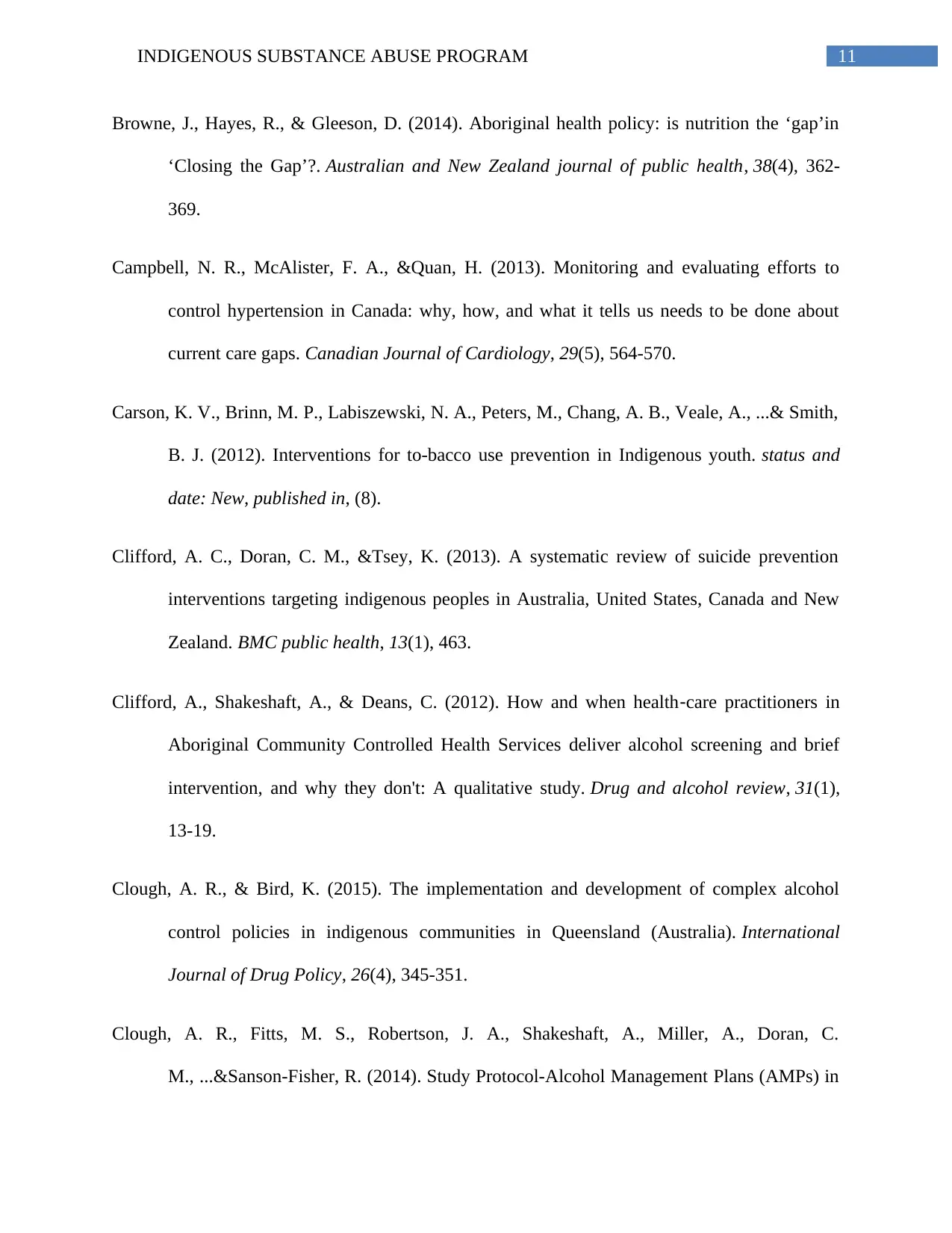
11INDIGENOUS SUBSTANCE ABUSE PROGRAM
Browne, J., Hayes, R., & Gleeson, D. (2014). Aboriginal health policy: is nutrition the ‘gap’in
‘Closing the Gap’?. Australian and New Zealand journal of public health, 38(4), 362-
369.
Campbell, N. R., McAlister, F. A., &Quan, H. (2013). Monitoring and evaluating efforts to
control hypertension in Canada: why, how, and what it tells us needs to be done about
current care gaps. Canadian Journal of Cardiology, 29(5), 564-570.
Carson, K. V., Brinn, M. P., Labiszewski, N. A., Peters, M., Chang, A. B., Veale, A., ...& Smith,
B. J. (2012). Interventions for to-bacco use prevention in Indigenous youth. status and
date: New, published in, (8).
Clifford, A. C., Doran, C. M., &Tsey, K. (2013). A systematic review of suicide prevention
interventions targeting indigenous peoples in Australia, United States, Canada and New
Zealand. BMC public health, 13(1), 463.
Clifford, A., Shakeshaft, A., & Deans, C. (2012). How and when health‐care practitioners in
Aboriginal Community Controlled Health Services deliver alcohol screening and brief
intervention, and why they don't: A qualitative study. Drug and alcohol review, 31(1),
13-19.
Clough, A. R., & Bird, K. (2015). The implementation and development of complex alcohol
control policies in indigenous communities in Queensland (Australia). International
Journal of Drug Policy, 26(4), 345-351.
Clough, A. R., Fitts, M. S., Robertson, J. A., Shakeshaft, A., Miller, A., Doran, C.
M., ...&Sanson-Fisher, R. (2014). Study Protocol-Alcohol Management Plans (AMPs) in
Browne, J., Hayes, R., & Gleeson, D. (2014). Aboriginal health policy: is nutrition the ‘gap’in
‘Closing the Gap’?. Australian and New Zealand journal of public health, 38(4), 362-
369.
Campbell, N. R., McAlister, F. A., &Quan, H. (2013). Monitoring and evaluating efforts to
control hypertension in Canada: why, how, and what it tells us needs to be done about
current care gaps. Canadian Journal of Cardiology, 29(5), 564-570.
Carson, K. V., Brinn, M. P., Labiszewski, N. A., Peters, M., Chang, A. B., Veale, A., ...& Smith,
B. J. (2012). Interventions for to-bacco use prevention in Indigenous youth. status and
date: New, published in, (8).
Clifford, A. C., Doran, C. M., &Tsey, K. (2013). A systematic review of suicide prevention
interventions targeting indigenous peoples in Australia, United States, Canada and New
Zealand. BMC public health, 13(1), 463.
Clifford, A., Shakeshaft, A., & Deans, C. (2012). How and when health‐care practitioners in
Aboriginal Community Controlled Health Services deliver alcohol screening and brief
intervention, and why they don't: A qualitative study. Drug and alcohol review, 31(1),
13-19.
Clough, A. R., & Bird, K. (2015). The implementation and development of complex alcohol
control policies in indigenous communities in Queensland (Australia). International
Journal of Drug Policy, 26(4), 345-351.
Clough, A. R., Fitts, M. S., Robertson, J. A., Shakeshaft, A., Miller, A., Doran, C.
M., ...&Sanson-Fisher, R. (2014). Study Protocol-Alcohol Management Plans (AMPs) in
⊘ This is a preview!⊘
Do you want full access?
Subscribe today to unlock all pages.

Trusted by 1+ million students worldwide
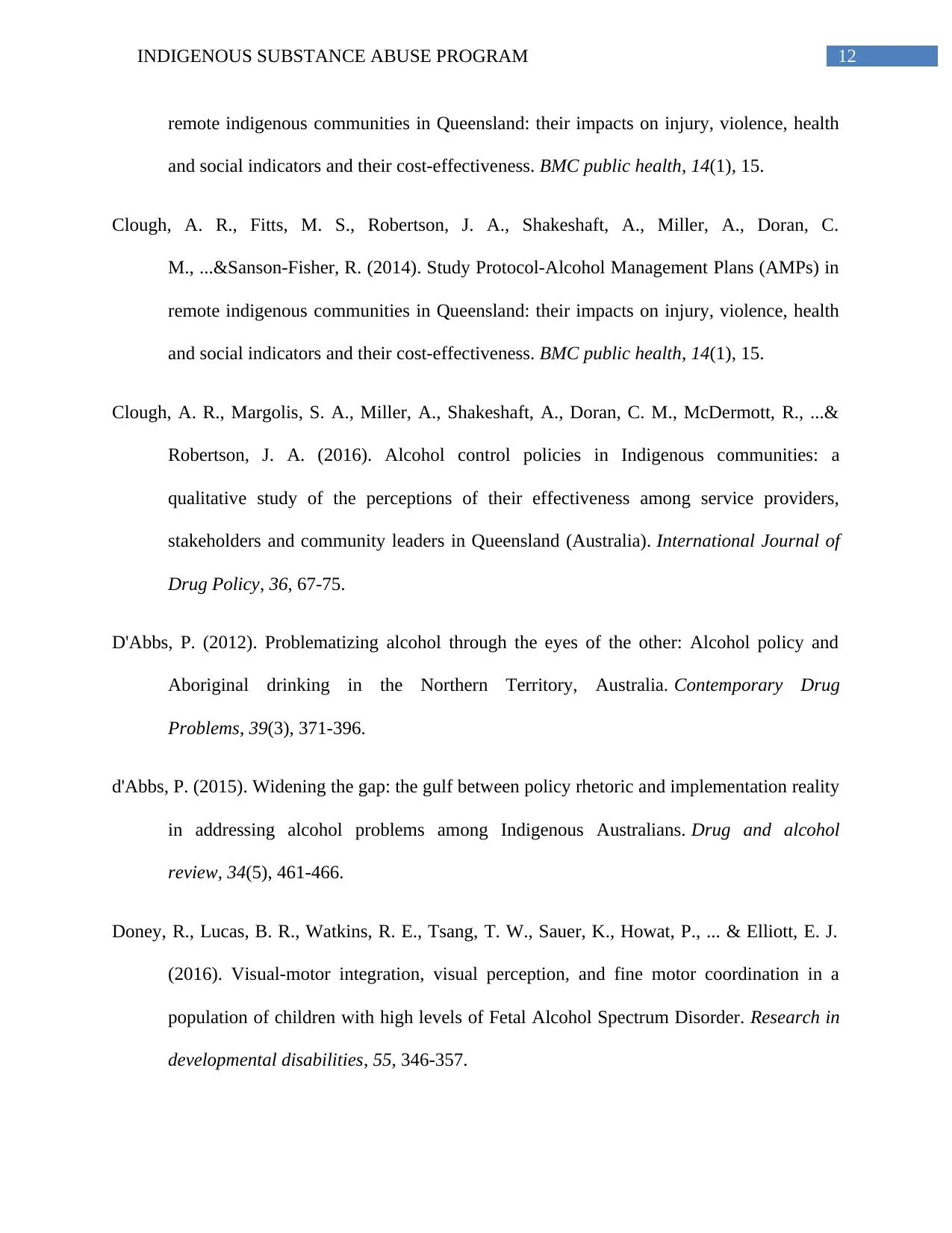
12INDIGENOUS SUBSTANCE ABUSE PROGRAM
remote indigenous communities in Queensland: their impacts on injury, violence, health
and social indicators and their cost-effectiveness. BMC public health, 14(1), 15.
Clough, A. R., Fitts, M. S., Robertson, J. A., Shakeshaft, A., Miller, A., Doran, C.
M., ...&Sanson-Fisher, R. (2014). Study Protocol-Alcohol Management Plans (AMPs) in
remote indigenous communities in Queensland: their impacts on injury, violence, health
and social indicators and their cost-effectiveness. BMC public health, 14(1), 15.
Clough, A. R., Margolis, S. A., Miller, A., Shakeshaft, A., Doran, C. M., McDermott, R., ...&
Robertson, J. A. (2016). Alcohol control policies in Indigenous communities: a
qualitative study of the perceptions of their effectiveness among service providers,
stakeholders and community leaders in Queensland (Australia). International Journal of
Drug Policy, 36, 67-75.
D'Abbs, P. (2012). Problematizing alcohol through the eyes of the other: Alcohol policy and
Aboriginal drinking in the Northern Territory, Australia. Contemporary Drug
Problems, 39(3), 371-396.
d'Abbs, P. (2015). Widening the gap: the gulf between policy rhetoric and implementation reality
in addressing alcohol problems among Indigenous Australians. Drug and alcohol
review, 34(5), 461-466.
Doney, R., Lucas, B. R., Watkins, R. E., Tsang, T. W., Sauer, K., Howat, P., ... & Elliott, E. J.
(2016). Visual-motor integration, visual perception, and fine motor coordination in a
population of children with high levels of Fetal Alcohol Spectrum Disorder. Research in
developmental disabilities, 55, 346-357.
remote indigenous communities in Queensland: their impacts on injury, violence, health
and social indicators and their cost-effectiveness. BMC public health, 14(1), 15.
Clough, A. R., Fitts, M. S., Robertson, J. A., Shakeshaft, A., Miller, A., Doran, C.
M., ...&Sanson-Fisher, R. (2014). Study Protocol-Alcohol Management Plans (AMPs) in
remote indigenous communities in Queensland: their impacts on injury, violence, health
and social indicators and their cost-effectiveness. BMC public health, 14(1), 15.
Clough, A. R., Margolis, S. A., Miller, A., Shakeshaft, A., Doran, C. M., McDermott, R., ...&
Robertson, J. A. (2016). Alcohol control policies in Indigenous communities: a
qualitative study of the perceptions of their effectiveness among service providers,
stakeholders and community leaders in Queensland (Australia). International Journal of
Drug Policy, 36, 67-75.
D'Abbs, P. (2012). Problematizing alcohol through the eyes of the other: Alcohol policy and
Aboriginal drinking in the Northern Territory, Australia. Contemporary Drug
Problems, 39(3), 371-396.
d'Abbs, P. (2015). Widening the gap: the gulf between policy rhetoric and implementation reality
in addressing alcohol problems among Indigenous Australians. Drug and alcohol
review, 34(5), 461-466.
Doney, R., Lucas, B. R., Watkins, R. E., Tsang, T. W., Sauer, K., Howat, P., ... & Elliott, E. J.
(2016). Visual-motor integration, visual perception, and fine motor coordination in a
population of children with high levels of Fetal Alcohol Spectrum Disorder. Research in
developmental disabilities, 55, 346-357.
Paraphrase This Document
Need a fresh take? Get an instant paraphrase of this document with our AI Paraphraser

13INDIGENOUS SUBSTANCE ABUSE PROGRAM
Dossetor, P. J., Martiniuk, A. L., Fitzpatrick, J. P., Oscar, J., Carter, M., Watkins, R., ...& Harley,
D. (2017). Pediatric hospital admissions in Indigenous children: a population-based study
in remote Australia. BMC pediatrics, 17(1), 195.
Earl, J. K., Bednall, T. C., &Muratore, A. M. (2015). A matter of time: Why some people plan
for retirement and others do not. Work, Aging and Retirement, 1(2), 181-189.
Fitzpatrick, J. P., Latimer, J., Carter, M., Oscar, J., Ferreira, M. L., Carmichael Olson, H., ...&
Hawkes, G. (2015). Prevalence of fetal alcohol syndrome in a population‐based sample
of children living in remote Australia: The Lililwan Project. Journal of paediatrics and
child health, 51(4), 450-457.
Gracey, M. (2014). Why closing the Aboriginal health gap is so elusive. Internal medicine
journal, 44(11), 1141-1143.
Holliday, S., Hayes, C., & Dunlop, A. (2013). Opioid use in chronic non-cancer pain: Part 2:
Prescribing issues and alternatives. Australian family physician, 42(3), 104.
Howes, F., Warnecke, E., & Nelson, M. (2013). Barriers to lifestyle risk factor assessment and
management in hypertension: a qualitative study of Australian general
practitioners. Journal of human hypertension, 27(8), 474.
Hudson. S. (2011). Alcohol Restrictions in Indigenous Communities and Frontier
Towns. Retrieved from http://www.cis.org.au/app/uploads/2015/07/pm116.pdf.
Jayaraj, R., Whitty, M., Thomas, M., Kavangh, D., Palmer, D., Thomson, V., ...& Nagel, T.
(2013). Prevention of Alcohol-Related Crime and Trauma (PACT): brief interventions in
routine care pathway–a study protocol. BMC public health, 13(1), 49.
Dossetor, P. J., Martiniuk, A. L., Fitzpatrick, J. P., Oscar, J., Carter, M., Watkins, R., ...& Harley,
D. (2017). Pediatric hospital admissions in Indigenous children: a population-based study
in remote Australia. BMC pediatrics, 17(1), 195.
Earl, J. K., Bednall, T. C., &Muratore, A. M. (2015). A matter of time: Why some people plan
for retirement and others do not. Work, Aging and Retirement, 1(2), 181-189.
Fitzpatrick, J. P., Latimer, J., Carter, M., Oscar, J., Ferreira, M. L., Carmichael Olson, H., ...&
Hawkes, G. (2015). Prevalence of fetal alcohol syndrome in a population‐based sample
of children living in remote Australia: The Lililwan Project. Journal of paediatrics and
child health, 51(4), 450-457.
Gracey, M. (2014). Why closing the Aboriginal health gap is so elusive. Internal medicine
journal, 44(11), 1141-1143.
Holliday, S., Hayes, C., & Dunlop, A. (2013). Opioid use in chronic non-cancer pain: Part 2:
Prescribing issues and alternatives. Australian family physician, 42(3), 104.
Howes, F., Warnecke, E., & Nelson, M. (2013). Barriers to lifestyle risk factor assessment and
management in hypertension: a qualitative study of Australian general
practitioners. Journal of human hypertension, 27(8), 474.
Hudson. S. (2011). Alcohol Restrictions in Indigenous Communities and Frontier
Towns. Retrieved from http://www.cis.org.au/app/uploads/2015/07/pm116.pdf.
Jayaraj, R., Whitty, M., Thomas, M., Kavangh, D., Palmer, D., Thomson, V., ...& Nagel, T.
(2013). Prevention of Alcohol-Related Crime and Trauma (PACT): brief interventions in
routine care pathway–a study protocol. BMC public health, 13(1), 49.

14INDIGENOUS SUBSTANCE ABUSE PROGRAM
Jorm, A. F., Bourchier, S. J., Cvetkovski, S., & Stewart, G. (2012). Mental health of Indigenous
Australians: a review of findings from community surveys. Medical Journal of
Australia, 196(2), 118.
Kumar, G. S., & Klein, R. (2013). Effectiveness of case management strategies in reducing
emergency department visits in frequent user patient populations: a systematic
review. Journal of Emergency Medicine, 44(3), 717-729.
McCalman, J., Tsey, K., Clifford, A., Earles, W., Shakeshaft, A., & Bainbridge, R. (2012).
Applying what works: a systematic search of the transfer and implementation of
promising Indigenous Australian health services and programs. BMC Public
Health, 12(1), 600.
Nadew, G. T. (2012). Exposure to traumatic events, prevalence of posttraumatic stress disorder
and alcohol abuse in Aboriginal communities. Rural and remote health, 12(4), 1667.
Queensland Government. (2017). Alcohol Management Plan. Retrieved from
https://www.datsip.qld.gov.au/publications-governance-resources/policy-governance/
alcohol-management-plan.
Queensland Treasury and Trade. (2011). Alcohol Management Plan Review. Retrieved from
https://www.datsip.qld.gov.au/resources/datsima/publications/policy/amp/amp-
review.pdf.
Rosenberg, S., &Hickie, I. (2013). Managing madness: mental health and complexity in public
policy. Evidence Base, 3, 1-19.
Jorm, A. F., Bourchier, S. J., Cvetkovski, S., & Stewart, G. (2012). Mental health of Indigenous
Australians: a review of findings from community surveys. Medical Journal of
Australia, 196(2), 118.
Kumar, G. S., & Klein, R. (2013). Effectiveness of case management strategies in reducing
emergency department visits in frequent user patient populations: a systematic
review. Journal of Emergency Medicine, 44(3), 717-729.
McCalman, J., Tsey, K., Clifford, A., Earles, W., Shakeshaft, A., & Bainbridge, R. (2012).
Applying what works: a systematic search of the transfer and implementation of
promising Indigenous Australian health services and programs. BMC Public
Health, 12(1), 600.
Nadew, G. T. (2012). Exposure to traumatic events, prevalence of posttraumatic stress disorder
and alcohol abuse in Aboriginal communities. Rural and remote health, 12(4), 1667.
Queensland Government. (2017). Alcohol Management Plan. Retrieved from
https://www.datsip.qld.gov.au/publications-governance-resources/policy-governance/
alcohol-management-plan.
Queensland Treasury and Trade. (2011). Alcohol Management Plan Review. Retrieved from
https://www.datsip.qld.gov.au/resources/datsima/publications/policy/amp/amp-
review.pdf.
Rosenberg, S., &Hickie, I. (2013). Managing madness: mental health and complexity in public
policy. Evidence Base, 3, 1-19.
⊘ This is a preview!⊘
Do you want full access?
Subscribe today to unlock all pages.

Trusted by 1+ million students worldwide

15INDIGENOUS SUBSTANCE ABUSE PROGRAM
Shepherd, S. M., Adams, Y., McEntyre, E., & Walker, R. (2014). Violence risk assessment in
Australian Aboriginal offender populations: A review of the literature. Psychology,
Public Policy, and Law, 20(3), 281.
Singleton, R. J., Valery, P. C., Morris, P., Byrnes, C. A., Grimwood, K., Redding, G., ... &
Holman, R. C. (2014). Indigenous children from three countries with non‐cystic fibrosis
chronic suppurative lung disease/bronchiectasis. Pediatric pulmonology, 49(2), 189-200.
Steenkamp, M., Rumbold, A., Barclay, L., &Kildea, S. (2012). A population-based investigation
into inequalities amongst Indigenous mothers and newborns by place of residence in the
Northern territory, Australia. BMC pregnancy and childbirth, 12(1), 44.
The Lowitja Institute. (2018). Alcohol management plans in Indigenous Australia. Retrieved
from https://www.lowitja.org.au/alcohol-management-plans-indigenous-australia
Watkins, R. E., Elliott, E. J., Wilkins, A., Mutch, R. C., Fitzpatrick, J. P., Payne, J. M., ... &
Halliday, J. (2013). Recommendations from a consensus development workshop on the
diagnosis of fetal alcohol spectrum disorders in Australia. BMC pediatrics, 13(1), 156.
Woodward, E., Jackson, S., Finn, M., &McTaggart, P. M. (2012). Utilising Indigenous seasonal
knowledge to understand aquatic resource use and inform water resource management in
northern Australia. Ecological Management & Restoration, 13(1), 58-64.
World Health Organization, & World Health Organization. Management of Substance Abuse
Unit. (2014). Global status report on alcohol and health, 2014. World Health
Organization.
Shepherd, S. M., Adams, Y., McEntyre, E., & Walker, R. (2014). Violence risk assessment in
Australian Aboriginal offender populations: A review of the literature. Psychology,
Public Policy, and Law, 20(3), 281.
Singleton, R. J., Valery, P. C., Morris, P., Byrnes, C. A., Grimwood, K., Redding, G., ... &
Holman, R. C. (2014). Indigenous children from three countries with non‐cystic fibrosis
chronic suppurative lung disease/bronchiectasis. Pediatric pulmonology, 49(2), 189-200.
Steenkamp, M., Rumbold, A., Barclay, L., &Kildea, S. (2012). A population-based investigation
into inequalities amongst Indigenous mothers and newborns by place of residence in the
Northern territory, Australia. BMC pregnancy and childbirth, 12(1), 44.
The Lowitja Institute. (2018). Alcohol management plans in Indigenous Australia. Retrieved
from https://www.lowitja.org.au/alcohol-management-plans-indigenous-australia
Watkins, R. E., Elliott, E. J., Wilkins, A., Mutch, R. C., Fitzpatrick, J. P., Payne, J. M., ... &
Halliday, J. (2013). Recommendations from a consensus development workshop on the
diagnosis of fetal alcohol spectrum disorders in Australia. BMC pediatrics, 13(1), 156.
Woodward, E., Jackson, S., Finn, M., &McTaggart, P. M. (2012). Utilising Indigenous seasonal
knowledge to understand aquatic resource use and inform water resource management in
northern Australia. Ecological Management & Restoration, 13(1), 58-64.
World Health Organization, & World Health Organization. Management of Substance Abuse
Unit. (2014). Global status report on alcohol and health, 2014. World Health
Organization.
1 out of 16
Related Documents
Your All-in-One AI-Powered Toolkit for Academic Success.
+13062052269
info@desklib.com
Available 24*7 on WhatsApp / Email
![[object Object]](/_next/static/media/star-bottom.7253800d.svg)
Unlock your academic potential
© 2024 | Zucol Services PVT LTD | All rights reserved.





